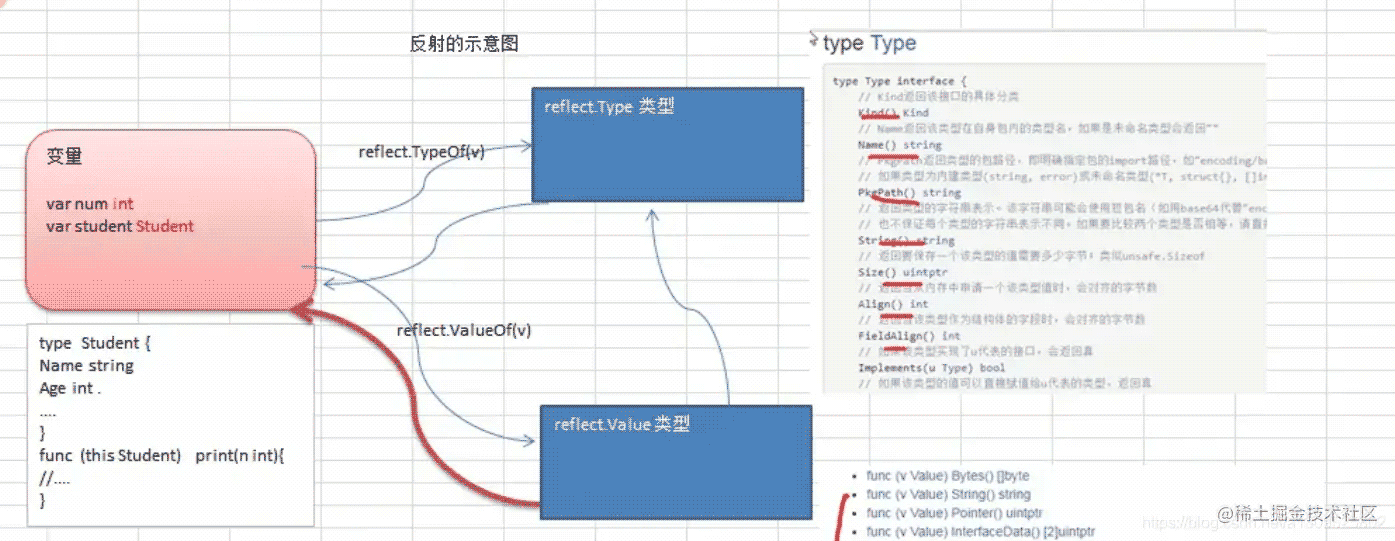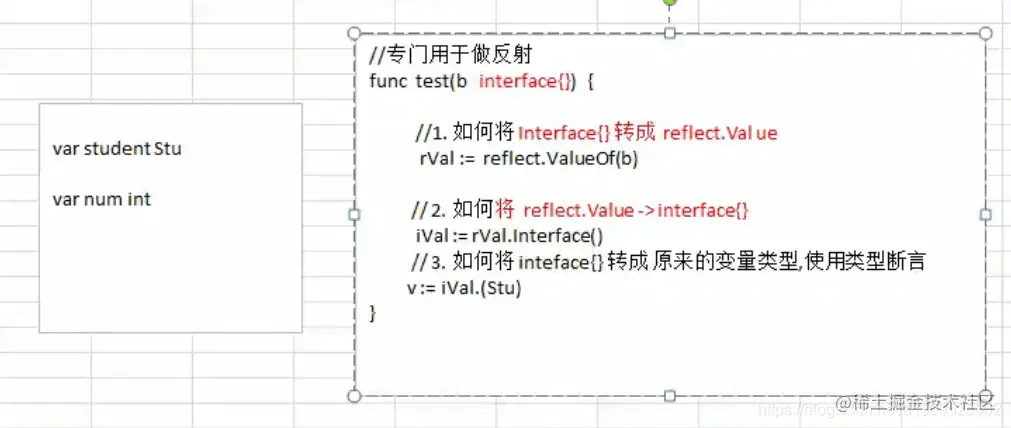| 导读 | 这篇文章主要为大家介绍了Go语言开发框架反射机制及常见函数示例详解,有需要的朋友可以借鉴参考下,希望能够有所帮助,祝大家多多进步,早日升职加薪 |
基本介绍
示意图

反射中常见函数和概念
reflect.TypeOf(变量名)
获取变量的类型,返回reflect.Type类型
reflect.ValueOf(变量名)
获取变量的值,返回reflect.Value类型reflect.Value是一个结构体类型,通过reflect.Value,可以获取到关于该变量的很多信息
变量.interface{}和reflect.Value是可以相互转换的

基本使用
package main
import (
"fmt"
"reflect"
)
/*
1.编写案例,对基本数据类型,interface{},reflect.Value进行反射
2.编写案例,对结构体,interface{},reflect.Value进行反射
*/
func reflectTest(b interface{}){
//打印出传参的type,kind,value
fmt.Printf("b的类型为%v,b的kind为%v,value为%v\n",reflect.TypeOf(b),reflect.ValueOf(b).Kind(),reflect.ValueOf(b)) //b的类型为int,b的kind为int,value为100
//reflect.TypeOf(),reflect.ValueOf()返回的类型
fmt.Printf("reflect.TypeOf()返回类型为%T,reflect.ValueOf()返回类型为%T\n",reflect.TypeOf(b),reflect.ValueOf(b)) //reflect.TypeOf()返回类型为*reflect.rtype,reflect.ValueOf()返回类型为reflect.Value
}
type Student struct {
Name string
age int
}
func reflectTest2(b interface{}){
rTyp:=reflect.TypeOf(b)
fmt.Println(rTyp) //main.Student
rVal:=reflect.ValueOf(b)
//将rVal转换成interface{}
iV:=rVal.Interface()
fmt.Printf("iv=%v type=%T\n",iV,iV) //iv={张三 18} type=main.Student
//因为Go语言是静态语言,所以不能直接获取结构体中指定的值,所以我需要将其断言成需要的类型
stu,ok:=iV.(Student)
if ok{
fmt.Printf(stu.Name,stu.age) //张三%!(EXTRA int=18)
}
}
func main() {
//1.编写案例,对基本数据类型,interface{},reflect.Value进行反射
var num int =100
reflectTest(num)
//2.编写案例,对结构体,interface{},reflect.Value进行反射
stu:=Student{
Name: "张三",
age: 18,
}
reflectTest2(stu)
}
反射注意事项
反射的最佳实践
使用反射来遍历结构体的字段,调用结构体的方法,并获取结构体标签的值
package main
import (
"fmt"
"reflect"
)
//定义了一个Monster结构体
type Monster struct {
Name string `json:"name"`
Age int `json:"monster_age"`
Score float32 `json:"成绩"`
Sex string
}
//方法,返回两个数的和
func (s Monster) GetSum(n1, n2 int) int {
return n1 + n2
}
//方法, 接收四个值,给s赋值
func (s Monster) Set(name string, age int, score float32, sex string) {
s.Name = name
s.Age = age
s.Score = score
s.Sex = sex
}
//方法,显示s的值
func (s Monster) Print() {
fmt.Println("---start~----")
fmt.Println(s)
fmt.Println("---end~----")
}
func TestStruct(a interface{}) {
//获取reflect.Type 类型
typ := reflect.TypeOf(a)
//获取reflect.Value 类型
val := reflect.ValueOf(a)
//获取到a对应的类别
kd := val.Kind()
//如果传入的不是struct,就退出
if kd != reflect.Struct {
fmt.Println("expect struct")
return
}
//获取到该结构体有几个字段
num := val.NumField()
fmt.Printf("struct has %d fields\n", num) //4
//变量结构体的所有字段
for i := 0; i < num; i++ {
fmt.Printf("Field %d: 值为=%v\n", i, val.Field(i))
//获取到struct标签, 注意需要通过reflect.Type来获取tag标签的值
tagVal := typ.Field(i).Tag.Get("json")
//如果该字段于tag标签就显示,否则就不显示
if tagVal != "" {
fmt.Printf("Field %d: tag为=%v\n", i, tagVal)
}
}
//获取到该结构体有多少个方法
numOfMethod := val.NumMethod()
fmt.Printf("struct has %d methods\n", numOfMethod)
//var params []reflect.Value
//方法的排序默认是按照 函数名的排序(ASCII码)
val.Method(1).Call(nil) //获取到第二个方法。调用它
//调用结构体的第1个方法Method(0)
var params []reflect.Value //声明了 []reflect.Value
params = append(params, reflect.ValueOf(10))
params = append(params, reflect.ValueOf(40))
res := val.Method(0).Call(params) //传入的参数是 []reflect.Value, 返回[]reflect.Value
fmt.Println("res=", res[0].Int()) //返回结果, 返回的结果是 []reflect.Value*/
}
func main() {
//创建了一个Monster实例
var a Monster = Monster{
Name: "黄鼠狼精",
Age: 400,
Score: 30.8,
}
//将Monster实例传递给TestStruct函数
TestStruct(a)
}
以上就是Go语言开发框架反射机制及常见函数示例详解的详细内容
原文来自:https://www.jb51.net/article/263627.htm
本文地址:https://www.linuxprobe.com/go-sister-linux.html编辑:倪家兴,审核员:逄增宝
Linux命令大全:https://www.linuxcool.com/
Linux系统大全:https://www.linuxdown.com/
红帽认证RHCE考试心得:https://www.rhce.net/









